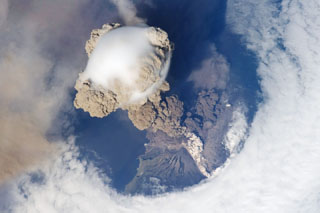Report on Sarychev Peak (Russia) — March 1989
Scientific Event Alert Network Bulletin, vol. 14, no. 3 (March 1989)
Managing Editor: Lindsay McClelland.
Sarychev Peak (Russia) Ash eruptions in mid-January; ashfall bands seen on the snow
Please cite this report as:
Global Volcanism Program, 1989. Report on Sarychev Peak (Russia) (McClelland, L., ed.). Scientific Event Alert Network Bulletin, 14:3. Smithsonian Institution. https://doi.org/10.5479/si.GVP.SEAN198903-290240
Sarychev Peak
Russia
48.092°N, 153.2°E; summit elev. 1496 m
All times are local (unless otherwise noted)
An ash eruption was reported on 14 January at 1136. During an overflight between 1220 and 1250, clouds at 1,300-1,800 m altitude obscured the summit . . . . No eruption columns were observed above the weather clouds. Two narrow gray bands on the volcano's snow-covered N and NE slopes suggested ash emission had occurred the previous day. The activity was preceded by a series of felt earthquakes 5-12 January. Epicenters of some strong earthquakes (M<=6.2) were located in the Simushir Island region . . . .
Geological Summary. Sarychev Peak, one of the most active volcanoes of the Kuril Islands, occupies the NW end of Matua Island in the central Kuriles. The andesitic central cone was constructed within a 3-3.5-km-wide caldera, whose rim is exposed only on the SW side. A dramatic 250-m-wide, very steep-walled crater with a jagged rim caps the volcano. The substantially higher SE rim forms the 1496 m high point of the island. Fresh-looking lava flows, prior to activity in 2009, had descended in all directions, often forming capes along the coast. Much of the lower-angle outer flanks of the volcano are overlain by pyroclastic-flow deposits. Eruptions have been recorded since the 1760s and include both quiet lava effusion and violent explosions. Large eruptions in 1946 and 2009 produced pyroclastic flows that reached the sea.
Information Contacts: G.S. Steinberg, Institute of Marine Geology & Geophysics, Yuzhno-Sakhalinsk.

